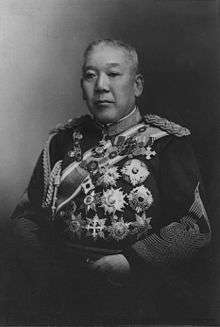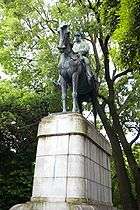Ōyama Iwao
| Ōyama Iwao | |
|---|---|
 | |
| Born |
12 November 1842 Kajiya-Chō, Kagoshima-Jōka, Satsuma-han, Japan |
| Died |
10 December 1916 (aged 74) Tokyo, Japan |
| Allegiance |
|
| Service/branch |
|
| Years of service | 1871–1914 |
| Rank | Field Marshal |
| Battles/wars | |
| Awards |
|
| Other work | Lord Keeper of the Privy Seal |
Prince Ōyama Iwao, OM (大山 巌, 12 November 1842 – 10 December 1916) was a Japanese field marshal, and one of the founders of the Imperial Japanese Army.
The community of Oyama, British Columbia, in Canada is named after Prince Ōyama Iwao.[1]
Biography
Early life
Ōyama was born in Kagoshima to a samurai family of the Satsuma Domain. A protégé of Ōkubo Toshimichi, he worked to overthrow the Tokugawa Shogunate and thus played a major role in the Meiji Restoration. He served as the commander of the Detached First Brigade during the Boshin War. At the Battle of Aizu, Ōyama was a commander at the Satchō Alliance's field artillery positions on Mount Oda. During the course of the siege, he was wounded by an Aizu guerilla force under Sagawa Kanbei.

Military career
In 1870, Ōyama was sent overseas to the École spéciale militaire de Saint-Cyr in France to study and he was official Japanese military observer to the Franco-Prussian War. He also spent three years (1870–1873) in Geneva studying foreign languages, and became fluent in Russian. Ōyama Iwao is the first recorded Japanese customer for Louis Vuitton, having purchased some luggage during his stay in France. After promotion to major general, he went to France again for further study, together with Kawakami Sōroku.[2] On his return home, he helped establish the fledgling Imperial Japanese Army, which was soon employed in suppressing the Satsuma Rebellion, although Ōyama and his elder brother were cousins of Saigō Takamori.
In the First Sino-Japanese War, Ōyama was appointed the commander-in-chief of the Japanese Second Army, which after landing on Liaotung Peninsula, carried Port Arthur by storm, and subsequently crossed to Shantung, where it captured the fortress of Weihaiwei. After the war, Ōyama was disparaged by American reporter Trumbull White for failing to restrain his troops during the Port Arthur Massacre.[3]

For his services Ōyama received the title of marquis under the kazoku peerage system, and, three years later, he became a field-marshal. In the Russo-Japanese War of 1904–1905 he was appointed the Commander-in-Chief of the Japanese armies in Manchuria. Ōyama has complete authority over all Japanese land operations during the war, and personally directed the tactics of Japanese forces in all major battles, winning the Battle of Liaoyang and repulsing Russian counter-attacks at the Battle of Shaho and the Battle of Sandepu. He was replaced by General Kodama Gentarō briefly during early 1905 due to illness, but recovered to direct Japanese forces in the final Battle of Mukden.[4]
After Japan's victory, Emperor Meiji elevated him to the rank of prince (公爵 kōshaku),[5] the highest rank of the Empire of Japan.
Political career and death
As the War Minister in several cabinets and as the Chief of the Army General Staff, Ōyama upheld the autocratic power of the oligarchs (genrō) against democratic encroachments. However, unlike Yamagata Aritomo, Ōyama was reserved and tended to shun politics. From 1914 to his death he served as the Lord Keeper of the Privy Seal.
In 1906, Ōyama was awarded the Order of Merit by King Edward VII. His Japanese decorations included Order of the Golden Kite (1st class) and Order of the Chrysanthemum.
Ōyama died at the age of seventy five in 1916. Ōyama was a large man, and enjoyed large meals. His weight exceeded 210 lbs., and may have contributed to his death, possibly arising from diabetes.
Personal life

Family
Ōyama's first wife Sawa died of puerperal disorder. Second wife Sutematsu (a survivor of the Battle of Aizu, a sister of former Aizu retainers Yamakawa Hiroshi and Yamakawa Kenjirō) was one of the first female students sent to the United States as part of the Iwakura Mission in the early 1870s. She spent eleven years there, graduating from Vassar College in 1882.[6] In the next year she accepted her once enemy's proposal.
Ōyama was Emperor Meiji's first candidate for rearing future emperor Hirohito as a sort of surrogate father in 1901, in accordance with royal customs, but Ōyama declined and the role instead went to Count Kawamura Sumiyoshi.[7]
Ōyama's first son Takashi, a navy cadet, died in the accidental explosion and sinking of the cruiser Matsushima in 1908. Second son Kashiwa (ja) became an archaeologist after he retired from army.

House
Ōyama, who spoke and wrote several European languages fluently, also liked European-style architecture. During his tenure as the War Minister, he built a large house in Tokyo modelled after a German castle.
Although he was very pleased with the design, his wife Sutematsu did not like it at all, and insisted that the children's room be remodelled in Japanese style, so that they would not forget their Japanese heritage.[8] The house was destroyed by the Great Kantō earthquake in 1923.
Kimigayo
In 1869, the British military band instructor John William Fenton, who was then working in Yokohama as an o-yatoi gaikokujin, told the members of Japan's military band about the British national anthem "God Save the King" and emphasised the necessity of a similar national anthem for Japan. The band members requested artillery Captain Ōyama Iwao, who was well versed in Japanese and Chinese literature, to select appropriate words and Ōyama selected the poem which came to be used in Japan's national anthem kimigayo.
Honours
From the Japanese Wikipedia
Japanese
-
 Grand Cordon of the Order of the Rising Sun (1 November 1882; Second Class: 9 November 1877)
Grand Cordon of the Order of the Rising Sun (1 November 1882; Second Class: 9 November 1877) - Count (7 July 1884)
-
.png) Imperial Japanese Constitution Promulgation Commemorative Medal (25 November 1889)
Imperial Japanese Constitution Promulgation Commemorative Medal (25 November 1889) -
 Grand Cordon of the Order of the Paulownia Flowers (5 August 1895)
Grand Cordon of the Order of the Paulownia Flowers (5 August 1895) - Marquess (5 August 1895)
-
 1894–95 Sino-Japanese War Medal (18 November 1895)
1894–95 Sino-Japanese War Medal (18 November 1895) -
.png) 1904–05 Russo-Japanese War Medal (1 April 1906)
1904–05 Russo-Japanese War Medal (1 April 1906) -
 Order of the Golden Kite, First Class (1 April 1906; Second Class: 5 August 1895)
Order of the Golden Kite, First Class (1 April 1906; Second Class: 5 August 1895) -
 Collar of the Order of the Chrysanthemum (1 April 1906; Grand Cordon: 3 June 1902)
Collar of the Order of the Chrysanthemum (1 April 1906; Grand Cordon: 3 June 1902) - Prince (21 September 1907)
-
.png) Imperial Accession Commemorative Medal (10 November 1915)
Imperial Accession Commemorative Medal (10 November 1915) - Silver gift cup set (1 April 1916)
-
.png) First World War Medal (1 April 1916)
First World War Medal (1 April 1916)
Court order of precedence
- Senior sixth rank (May 1871)
- Senior fifth rank (24 February 1875)
- Fourth rank (16 December 1879)
- Senior fourth rank (24 May 1880)
- Third rank (27 December 1884)
- Second rank (19 October 1886)
- Senior second rank (20 December 1895)
- Junior First Rank (10 December 1916; posthumous)
Foreign
-
 Grand Cross of the Order of the Crown of Italy (20 March 1883)
Grand Cross of the Order of the Crown of Italy (20 March 1883) -
.png) Grand Cross of the Order of the Crown of Prussia (4 February 1884)
Grand Cross of the Order of the Crown of Prussia (4 February 1884) -
 Grand Cross of the Order of Saints Maurice and Lazarus of the Kingdom of Italy (9 February 1885)
Grand Cross of the Order of Saints Maurice and Lazarus of the Kingdom of Italy (9 February 1885) -
 Knight First Class of the Order of the Iron Crown of Austria-Hungary (9 February 1885)
Knight First Class of the Order of the Iron Crown of Austria-Hungary (9 February 1885) -
 Knight Grand Cordon of the Order of the White Eagle of the Russian Empire (1885)
Knight Grand Cordon of the Order of the White Eagle of the Russian Empire (1885) -
_ribbon.png) Order of the Crown of Thailand, 1st Class (1 May 1891)
Order of the Crown of Thailand, 1st Class (1 May 1891) -
 Order of Osmanieh, 1st Class of the Ottoman Empire (27 May 1891)
Order of Osmanieh, 1st Class of the Ottoman Empire (27 May 1891) -
.png) Order of Merit (OM) of the United Kingdom (5 April 1906)[9]
Order of Merit (OM) of the United Kingdom (5 April 1906)[9] -
 Grand Cross of the Legion of Honour of France (27 December 1906; Grand Officer: 13 April 1883)
Grand Cross of the Legion of Honour of France (27 December 1906; Grand Officer: 13 April 1883)
Other
- Namesake of small town in British Columbia Canada. Oyama, British Columbia.
See also
Notes
- ↑ "Oyama, Lake Country, Okanagan Valley, BC". vancouverisland.com. 1998. Retrieved 13 April 2012.
- ↑ Dupuy, Encyclopedia of Military Biography
- ↑ Trumbull White (1895). The War in the East. J. H. Moore and Company. pp. 597–606. Retrieved 9 August 2011.
- ↑ Kowner, Rotem (2006). Historical Dictionary of the Russo-Japanese War. ISBN 0-8108-4927-5: The Scarecrow Press.page 276
- ↑ National Diet Library, Portraits of Modern Historical Figures
- ↑ "Prince Iwao Oyama Is Dead in Japan", The New York Times, 11 December 1916.
- ↑ Bix, Herbert P. (2001). Hirohito and the making of modern Japan (1st Perennial ed.). New York: Perennial. p. 522. ISBN 978-0060931308.
- ↑ Adachi, The Wife of Japan's great General Oyama
- ↑ The London Gazette, 15 May 1906
References
- Bix, Herbert P. (2000). Hirohito and the Making of Modern Japan. New York: HarperCollins. ISBN 978-0-06-019314-0; OCLC 247018161
- Dupuy, Trevor N. (1992). Encyclopedia of Military Biography. I B Tauris & Co Ltd. ISBN 1-85043-569-3.
- Jansen, Marius B. and Gilbert Rozman, eds. (1986). Japan in Transition: from Tokugawa to Meiji. Princeton: Princeton University Press. ISBN 9780691054599; OCLC 12311985
- ____________. (2000). The Making of Modern Japan. Cambridge: Harvard University Press. ISBN 9780674003347; OCLC 44090600
- Keene, Donald. (2002). Emperor of Japan: Meiji and His World, 1852–1912. New York: Columbia University Press. ISBN 978-0-231-12340-2; OCLC 46731178
External links
| Wikimedia Commons has media related to Ōyama Iwao. |
- National Diet Library. "Oyama Iwao". Portraits of Modern Historical Figures.
- Adachi, Kinnosuke (23 July 1905). "The Wife of Japan's Great General Oyama". New York Times. Retrieved 20 May 2010.
- VancouverIsland.com. "Oyama, Lake Country, Okanagan Valley, BC".
| Political offices | ||
|---|---|---|
| Preceded by none |
Minister of War Dec 1885 – May 1891 |
Succeeded by Takashima Tomonosuke |
| Preceded by Takashima Tomonosuke |
Minister of War Aug 1892 – Sept 1896 |
Succeeded by Takashima Tomonosuke |
| Preceded by Prince Fushimi Sadanaru |
Lord Keeper of the Privy Seal Apr 1915 – Dec 1916 |
Succeeded by Matsukata Masayoshi |
| Military offices | ||
| Preceded by Yamagata Aritomo |
Chief of Imperial Japanese Army General Staff Sept 1882 – Feb 1884 |
Succeeded by Yamagata Aritomo |
| Preceded by Kawakami Soroku |
Chief of Imperial Japanese Army General Staff Jan 1888 – May 1899 |
Succeeded by Yamagata Aritomo |
| Preceded by Yamagata Aritomo |
Chief of Imperial Japanese Army General Staff Dec 1905 – Apr 1906 |
Succeeded by Kodama Gentarō |